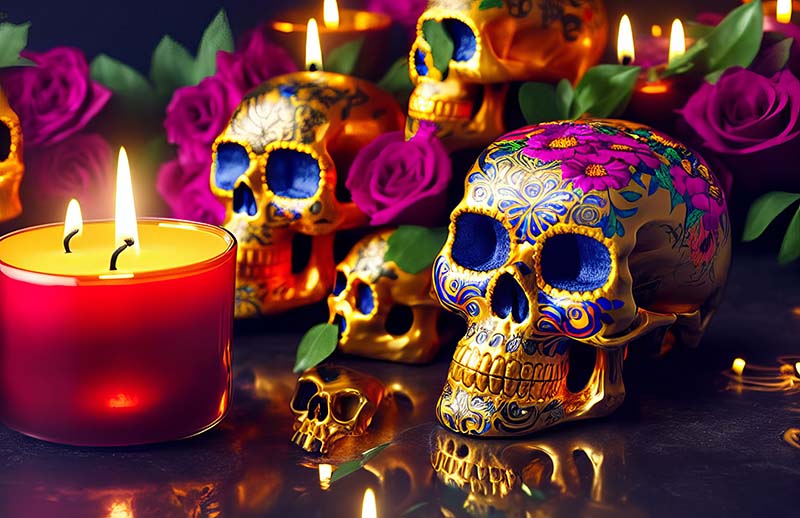
Dia de los Muertos
In Mexico, death rites date from pre-Hispanic rituals represented in murals, painted pottery, monuments, and artifacts, which shows how the Day of the Dead has its origins in the rituals practiced by the indigenous peoples of the Americas. Its precedents date to more than 3000 years ago when the Olmecs and subsequent Toltecs, Mixtecs, Zapotecs, Maya, and Aztecs honored death.
Those who passed are alive in our memories. A continuous echo that at certain occasions becomes louder. As the only answer to many of our questions, death is an integral part of life, and the living and the dead meet in this day to emphasize the importance of death in the cycle of life.
Día de los Muertos acknowledges the symbiotic relationship between life and death. El día de Los Muertos is celebrated on November 1st and November 2nd, in which the spirits of the dead are believed to return home and spend time with their relatives on these two days. To welcome them, the family build altars in their honor. These altars have a series of different components that vary from one culture to another that mostly include yellow marigolds, candles, photos of the deceased ones, papel picado or cut tissue-paper designs, as well as food and beverages offerings for the dead.
It is common to see skulls or calaveras as decorations. These can be made of papier-mâché, clay, wood, metal, cut-out tissue paper, and often, they are made of sugar decorated with colored icing, flowers, or metallic colored foils.
From the Archive: Download this teacher's handbook created in 1988 by the museum's education team.
The skull imagery is deeply influenced by Mexican artist José Guadalupe Posada’s famous etchings and illustrations of the Calavera Catrina—a female skeleton attired with a plumed hat.
Posada's calaveras were a critique of the society that surrounded the artist's life (from 1852 to 1913). His illustrations were political satirizations of the Mexican society of his time, where the artist caricatured and exposed class habits through his skull drawings and etchings. After Posada's death in 1913, his calaveras became a symbol for Día de Los Muertos. La calavera Catrina, originally calavera Garbancera, was a social critique of those who wanted to look up to the European bourgeoisie and despised their own Mexican-ness.
These literary calaveras or calaveras literarias are octavillas or eight octosyllabic verses that satirize the living styles of different social classes while highlighting death as the common destiny for the rich and the poor.
In the U.S., the altar-making rituals have been a cultural practice beyond the individual space, where museums, art galleries, community centers, and schools make their own altars for the Day of the Dead. The Chicano Movement introduced this celebration where its original elements went beyond the common family household and became a community expression of cultural heritage that commemorates the ancestors of the Americas. Public altars are built to honor important personalities of Chicanos and Mexican artists that have been influential to the Latino communities in California. Nowadays, el Día de los Muertos, is seen as an urban artistic phenomenon which bonds community. In San Francisco, the first documented Day of the Dead activities happened in the early 70s, and they have been gaining presence until today. La Galería de La Raza held the first Day of the Dead altar exhibition, organized by René Yañez and Ralph Maradiaga. Artist and curator René Yañez was an essential advocate in immersing this celebration into the city’s main festivities. He was also responsible for altars to become artistic installations while being respectful to its origins.
El Día de Los Muertos although predominant in Mexico, is also celebrated in other countries such as Bolivia, Ecuador, Peru, Guatemala, and Haiti. Day of the Dead Altars are meant to honor the returning souls on these two days. These altars are carefully decorated with objects that connect it with the four elements of nature by symbolical associations, as well as food and drinks to please the departed. Although different cultures share similar objects, each place has specific idiosyncratic elements, and every altar is unique in its own way.


